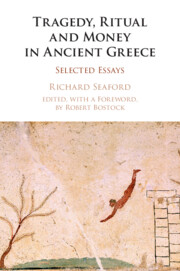Book contents
- Tragedy, Ritual and Money in Ancient Greece
- Tragedy, Ritual and Money in Ancient Greece
- Copyright page
- Contents
- Foreword
- Part I Tragedy: General
- Part II Performance and the Mysteries
- Part III Tragedy and Death Ritual
- Part IV Tragedy and Marriage
- Part V New Testament
- Part VI The Inner Self
- Part VII India and Greece
- Part VIII Money and Modernity
- References
- Index Locorum
- General Index
- References
References
Published online by Cambridge University Press: 02 November 2018
- Tragedy, Ritual and Money in Ancient Greece
- Tragedy, Ritual and Money in Ancient Greece
- Copyright page
- Contents
- Foreword
- Part I Tragedy: General
- Part II Performance and the Mysteries
- Part III Tragedy and Death Ritual
- Part IV Tragedy and Marriage
- Part V New Testament
- Part VI The Inner Self
- Part VII India and Greece
- Part VIII Money and Modernity
- References
- Index Locorum
- General Index
- References
- Type
- Chapter
- Information
- Tragedy, Ritual and Money in Ancient GreeceSelected Essays, pp. 441 - 468Publisher: Cambridge University PressPrint publication year: 2018



